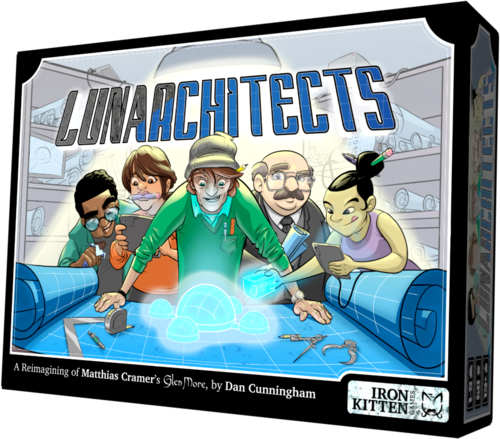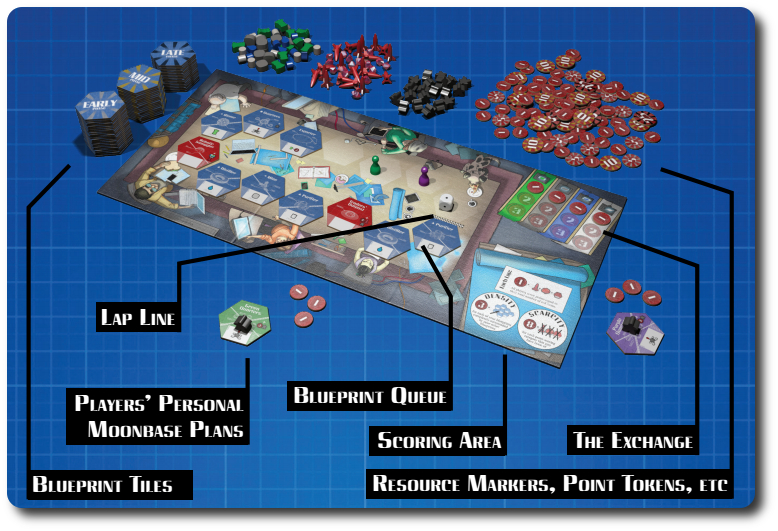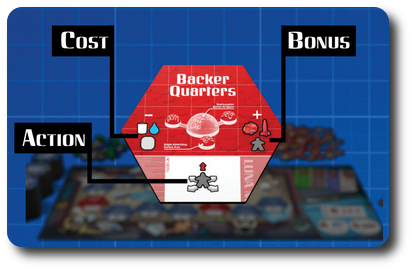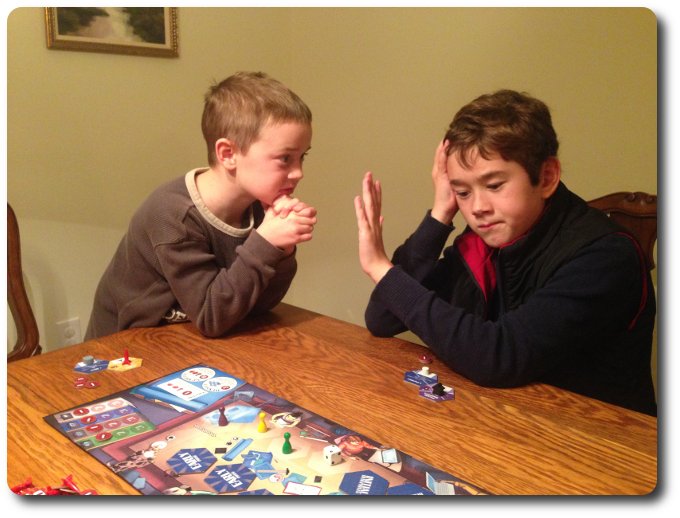Please Take Note: This is a review of the final game, but it might change slightly based on the success of the Kickstarter campaign. The game is being reviewed on the components and the rules provided with the understanding that “what you see is not what you might get” when the game is published. If you like what you read and want to learn more, we encourage you to visit the game publisher’s website or visit the Kickstarter campaign. Now that we have all that disclaimer junk out of the way, on with the review.

The Basics:
- For ages 8 and up (publisher suggests 13+)
- For 1 to 5 players
- Approximately 45 minutes to complete
Geek Skills:
- Counting & Math
- Logical & Critical Decision Making
- Pattern/Color Matching
- Strategy & Tactics
- Risk vs. Reward
- Visuospatial Skills
- Hand/Resource Management
- Worker Placement
Learning Curve:
- Child – Easy
- Adult – Easy
Theme & Narrative:
- Build a Moonbase that’s out of this world
Endorsements:
- Gamer Geek approved!
- Parent Geek approved!
- Child Geek approved!
Overview
The race to colonize the Moon has begun and your design firm has won the contract to build the first Moonbase. You are one of the rising architects in the firm and it’s up to you to make the dream of living on the Moon a reality. Everyone is counting on you! So, you know….no pressure.
Lunarchitects, designed by Dan Cunningham and to be published by Iron Kitten Games, will reportedly be comprised of 73 Blueprint tiles, 80 Point tokens (ranging in various number values), 10 Scoring Scheme plaques, 65 Resource pieces, 55 miniatures, 5 Player pawns, 1 Blueprint Queue game board, and 2 dice. The number of components to be included with the game has not been finalized and is expected to change based on the Kickstarter campaign’s total funding. As this is a review of a prepublished game, I cannot comment on the game component quality.
Note: Lunarchitects is a reimagined version of Glen More, but that’s where the similarities end. If you’ve played Glen More, you haven’t played Lunarchitects.
Prepping the Drafting Table
To set up the game, first place the Blueprint Queue game board in the middle of the playing area.
Second, have each player select 1 starting “Quarters” Blueprint tile and a matching colored Player pawn. Have each player place the starting “Quarters” Blueprint in front of them and orientated so the writing on the tile is facing correctly. Place any starting Blueprint and matching Player pawns that are not being used back in the game box.
Third, organize the Resources into their own piles. I suggest you use cups or bowls to help keep your playing area organized. When completed, you’ll have a pile for “Astronaut” Resources, “Rocket” Resources”, Point tokens, “Water” Resources, “Rock” Resources”, “Food” Resources, and “Crystal” Resources.
Fourth, hand to each player 3 Point tokens and 1 “Astronaut” Resource. The Point tokens are placed in front of the player or off to one side. The “Astronaut” Resource is placed on the player’s starting Blueprint tile.
Fifth, organize the Blueprint tiles into 4 different groups. These will be “Initial”, “Early”, “Mid”, and “Late”. Shuffle each stack and place them face-down.
Sixth, in the following order, place the listed items BEHIND the Lap Line starting with the first space on the Queue.
- The red die (but only if playing solo, otherwise skip it)
- The white die (but only if playing with 2 to 3 players, otherwise skip it)
- The Player pawns in whatever order is agreed upon by the players
Seventh, using the “Initial” Blueprint tiles, place 1 on each space, face-up, in FRONT of the Lap Line until there is only 1 empty space in the Queue (where “empty” means void of any die, pawn, or tile)
That’s it for game set up unless the players are customizing their scoring by using the Scoring Scheme plaques. See “Game Variants” for additional details.
When completed, your game set up will look similar to the following.

Manufacturing On the Moon
Players will need a number of items to build their ideal Moonbase. Specifically, they will need a number of Resources and the detailed instructions on how to use them, which are referred to as Blueprints. Note, however, that not all Resources are collected for building. Some are used to score points, as well.
Each of the items the players will be using are summarized here.
Air
On the Moon there is nothing to breath. Air is a necessary resource to keep the player’s Moonbase going, but only if they fill it with Astronauts. Air is a Resource to be acquired, but since it’s useful everywhere, it’s also a Resource to be sold for profit.
Water
Water is another rare Resource on the Moon. It can be created using sophisticated equipment, but the process is costly. Which is precisely why a player will use it to purchase new Blueprint tiles or make a profit by trading it on the Exchange.
Food
Food is necessary to sustain life, but not the number one thing on the list of “Must Haves”. This does not make it any less useful, however. Food is still a necessary component to build Blueprint tiles, but players might find it’s even more useful when selling it on the Exchange for Point tokens.
Rocks
The Moon is full of large deposits of precious metals. The wealth is there for the taking if a person is savvy enough to know how to mine it. Much of what is brought up from the mine is seemingly just Moon rock, but do not be deceived. These Rocks are useful with building Blueprint tiles and can be turned into Lunar Crystals which count as points.
Lunar Crystals
For those on the Moon, Lunar Crystals are less than a dime a dozen, but everyone back on Earth thinks they are the next best thing to gold. A player can earn a lot of points if they can turn their mined Moon Rock into Lunar Crystals.
Astronauts
Astronauts represent the workforce located on the Moonbase. A player cannot place a Blueprint tile to another Blueprint tile unless an “Astronaut” Resource is located on a Blueprint tile that will also be touching the new tile. This makes the Astronaut a very important resource in the game. Without it, the player cannot hope to build their Moonbase. Luckily for the player, they can have more than one Astronaut working hard to build their Moonbase of the future.
Rockets
If a player finds they have too many Astronauts with not enough to do, they can acquire a Blueprint tile that makes an Astronaut into an explorer. The “Astronaut” Resource piece is replaced with a “Rocket” Resource piece, indicating that the Astronaut is now exploring space instead of building spaces to live in.
Blueprints
The Blueprint tiles are the heart and soul of the game. The players will spend the vast majority of their time focusing on the Blueprints and their use. However, it’s also fitting to list them last, as they are dependent on all the other Resources listed above. Without Resources, the player cannot hope to acquire and use important Blueprints. Similarly, without Blueprints to aid them, the player will have difficulty acquiring Resources.
Each Blueprint lists how much it costs (the Resources that must be paid to acquire the Blueprint tile), the one time bonus the Blueprint tile provides the player, and the action that can be taken using the Blueprint tile. Some Blueprint tiles will also have illustrations of rails and tubes that must connect to other rails and tubes.

Blueprints are broken down into 4 different groups. These are “Initial”, “Early”, “Mid”, and “Late”. As the game progresses, the players will go through these groups in a specific order. In this way, the Blueprint tiles and the game gradually ramps up and evolves as the game progresses. The first stage is all about establishing the base on which the players will build their Moonbase, the next stage focuses on using the base and creating a more efficient machine. This continues all the way through the “Late” group, wherein players will be purchasing the most expensive Blueprints that will also be providing the most points.
Base Building
Lunarchitects is played in laps and turns. A lap is used to determined when scoring occurs. There are a total of 4 laps per game, but the number of turns will vary. A player’s turn is summarized here.
Step 1: Move Player Pawn
The player can move their Player pawn anywhere along the Queue, stopping on any Blueprint tile they want to claim. Pawns can move through and over other pawns.
Step 2: Pay for Blueprint and Visit Exchange
Blueprint tiles are not free. If the player wants to claim it, they must pay the listed Blueprint cost by returning the listed number of Resources back to their respective supplies.
If the player does not have the necessary number or type of Resources to pay for the Blueprint tile, they can use the Exchange. The Exchange will allow a player to add Point tokens to receive Resources on credit or sell extra Resources for Point tokens.
Buying Resource credits can be done as many times as the player likes, but only on their turn and only if the Resource credits they are purchasing are being used to acquire a Blueprint tile or to pay for the activation of an action. In other words, players cannot stockpile Resource credits for a later turn. Use them or lose them.
Selling Resources is done by returning a Resource to its supply and then taking a single stack of Point tokens from the Exchange that matches the Resource type. This action can be repeated as many times as the player likes on their turn if they have the Resources to spare.
Step 3: Place Blueprint
After acquiring the Blueprint tile, the player must place it by connecting it to at least 1 other previously places Blueprint tile. A few rules apply when placing the Blueprint tile.
- The Blueprint tile must be orientated so its title is on top from the owning player’s seated perspective.
- The Blueprint tile must be placed so it’s next to an “Astronaut” Resource that has been placed on another Blueprint tile.
- Connections must be maintained between any diagonal rail-to-rail or tube-to-tube lines from adjacent Blueprint tiles. The placement should not stop or create any additional lines for rails or tubes.
After the Blueprint has been placed, the player takes the one-time bonuses listed on the Blueprint tile’s right-most side. A few of the possible bonuses are listed here.
- Add any 2 Resources to the Blueprint tile.
- Earn 2 Point tokens for every Resource on the player’s Blueprint tiles.
- Activate any Blueprint tile this turn.
Step 4: Activate Blueprint Tiles
The player can now activate the placed Blueprint tile and all Blueprint tiles it’s connected to, for a total of 7 Blueprint tile activations. The order in which the actions are activated is up to the player, but each can only be used once. If the player requires additional Resources, they can always go to the Exchange.
There are a wide variety of actions provided by the Blueprint tiles. Here are a few.
- Move an “Astronaut” Resource to an adjacent Blueprint tile or exchange the “Astronaut” Resource for a “Rocket” Resource. “Rocket” Resources are placed with the player’s Point tokens for scoring.
- Add Resources to the Blueprint tile.
- Take Point tokens.
- Exchange Resources for Points tokens.
- Exchange a “Rock” Resource for a “Crystal” Resource. “Crystal” Resources are placed with the player’s Point tokens for scoring.
Step 5: Add to Queue
The player’s last action is to take Blueprint tiles from the Blueprint supply and add them to the front of the Queue, face-up, until there is only one open location behind the Player’s pawn and the dice.
The player’s turn is now over.
Who Goes Next?
The turn order sequence is not determined by seating position. As players advance through the Queue, they move around it like a track. When a player has finished their turn, the next player to go is the one who has their Player pawn in the last position in the Queue.
If the die on the Queue is last, meaning all Player pawns are ahead of it, the die is rolled and then advanced that many spaces in the Queue. If the space the die lands on contains a Blueprint tile, it’s removed. Then the Queue is reviewed again to determine which player goes next by determining who has their Player pawn in the last position in the Queue.
Scoring Big on the Moon
As the players traverse the Queue, they will eventually complete a lap by passing the “Lap Line”. After all the players have passed the Lap Line, points are scored. All players score a number of points equal to their total red Resources, which includes red Blueprints. For example, if a player had 3 red “Rocket” Resources, 4 red “Crystal” Resources and 2 red Blueprints, they would score 9 points. Points are tracked by collecting an equivalent number of Point tokens.
After scoring the 4th and final lap, two additional method of earning points are used. These are Density and Scarcity. Density awards the player 3 points for every Blueprint that is completely surrounded by other Blueprints. Scarcity awards the player 8 points for each Resource type they do not have, which is a pretty strong argument to never collect more Resources than what you think you’ll need.
When all the scoring is completed, players count their Point tokens. The player with the most Point tokens wins the game.
Game Variants
There are a number of ways to play Lunarchitects. Each game variant provided in the rules is summarized here.
Scoring Schemes
The game board lists the method to score points after each lap and at the end of the game. A number of Scoring Scheme plaques are provided that allows players to change how the game is scored. When used, they cover the scoring indicated on the game board, becoming the new scoring rules. Players can either randomly select which Scoring Scheme to use or decide as a group. Examples of different Scoring Schemes include Focus (score points based on types of Blueprints), Competition (award points to the player who has the most Resources), and Taxes (which penalizes players for having too many of a certain Blueprint). Mix and match to create games that require very different and challenging strategies and tactics to win.
Solo to the Moon
Lunarchitects can be played solo. All the same rules apply, but the red and white dice are included. It’s recommended that the player use the Independence and Taxes Scoring Schemes. The goal of the game is to score as many points as possible. A scale is provided to help players determine if they were below average or scored an amazing game.
To learn more about Lunarchitects, visit the game publisher’s website or visit the Kickstarter campaign.
Final Word
A number of the Child Geeks had already played Glen More and other tile games where collection and building with or for resources was a familiar game mechanic. For those Child Geeks that were brand new to the concepts introduced in Lunarchitects, the learning curve proved to be less than moderate, but not exactly easy. The difficulty came from understanding how all the Resources worked together, which is only something you can really learn by playing. Brilliantly, the game designer purposely designed the game to slowly build on its level of difficulty and depth of play. This proved to be exactly what the Child Geeks needed and wanted. According to one Child Geek, “At first, I was all kinds of not sure what to do. But as soon as you start playing, it all makes sense.” Another Child Geek said, “What I like best is that there is no bad way to play this game. You can play to win or just play to see how well you can do. It’s all fun.” So fun, in fact, that all the Child Geeks agreed to approve the game, finding Lunarchitects to be more entertained than they initially imagined.

After playing the game several times, we tried to play the first lap blind. We had a great time, but it was a bit more stressful.
The Parent Geeks were also very pleased by the game, finding it to be a casual affair that could easily be changed to a more challenging experience if the situation called for it. According to one Parent Geek, “I really like games like this that allow you to alter and modify how they are played without having to do much. This is a game I can bring to any gathering and I know I will be able to play it with anyone there.” Another Parent Geek said, “What I appreciated most was how you could change the game’s difficulty so easily, but you never really change how the game is played. The only thing you have to shift is your thinking.” From non-gamers to veteran Parent Geek gamers, all were pleased with how smooth the game played, its different levels of difficulty, and best of all, its high level of playability with friends and family.
The Gamer Geeks were impressed after the first game and even more so after the second. According to one Gamer Geek, “This is a very solid game. The level of depth is excellent, the strategic play is superb, and the tactical thinking is outstanding. Simply fantastic.” Another Gamer Geek said, “There’s a lot to consider at times, but what I like most is that the real focus is on what you need to do, not how you need to go about it. I like that, because it lets me concentrate on my strategy and less so on the tactics.” After several games, the only aspect of the game the Gamer Geeks didn’t care for was the die that randomly removed Blueprint tiles, but even this was seen as a “smart way” to keep the game moving at a brisk pace. Without hesitation, the Gamer Geeks voted to approve Lunarchitects.
The turn order in Lunarchitects is brilliant. It forces a player to consider the pros and cons of grabbing what they want with the perceive time it will take for them to take their next turn. Since a player is able to jump to any position in the Queue when it’s their turn, it’s possible to collect any Blueprint tile the player needs for their Moonbase. But not so fast. If the player jumps too far ahead, their next turn could be for a long way off, which means they won’t be able to take any actions and might miss out on some really important Blueprints. As such, the player is continually balancing the differences between Needs and Wants in their mind.
Another aspect of the game I really enjoyed was the building of my machine by way of the Blueprint tiles. When a Blueprint is placed, it’s activated along with those Blueprint tiles it’s connected to. This was a subtle, but excellent way to challenge a player to think about how they place their Blueprints on multiple levels. Connecting them is simply not enough. A player must also consider combos, activation order, and proper grouping. It really makes it an interesting challenge. But it’s important to note that a player is never put in a corner, either. There is always somewhere to place a Blueprint tile. The goal is to place it where it can be as useful as possible for as long as possible. It won’t be long until the first Blueprint tiles are closed off and a player will need to consider new ways to acquire Resources.
Finally, a brief word about the Queue. Visually, I did not find it that impressive, but it works. I was also skeptical of the dice that were used as “dummy players” (for lack of a better term) that eat up random Blueprint tiles. These, too, worked surprisingly well. In fact, it made the Queue interesting and a place where players had to consider how much they were willing to move and when to acquire a Blueprint token. You could feel the tension at times when the dice was rolled, which was a pleasant surprise.
Overall, I am most pleased with the game. It’s light enough to teach to new players, visually interesting, strategic on multiple levels, tactical on even more, and its depth of play is adjustable, allowing hardcore players to enjoy the same game as the casual players. Lunarchitects seemingly hits all the right buttons and checked all the right marks with our groups. I, for one, am in total agreement with their assessments. Lunarchitects is a game that is sure to be played again and again, as it never gets old and it never stopped satisfying. Do play this game when you get a chance. I think it’s out of this world.
This is a paid for review of the game’s final prototype. Although our time and focus was financially compensated, our words are our own. We’d need at least 10 million dollars before we started saying what other people wanted. Such is the statuesque and legendary integrity of Father Geek which cannot be bought except by those who own their own private islands and small countries.



